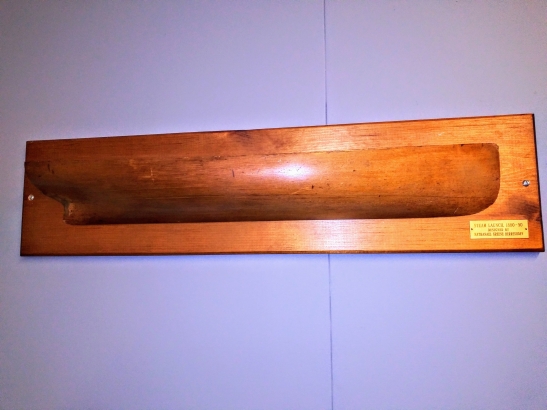Throughout the first floor of the Mary Robinson Research Center, we have several Hull models of different ships and boats, one of these Hull models is of the “Estelle No.1“, a steam-powered yacht. The Hull model is made out of wood and it was designed by Nathanael Greene Herreshoff in 1877. There is an inscription on the back by Herreshoff himself, it has built-in lifts, has a keel and is mounted on a plaque. The Hull model was gifted to us by Mr. and Mrs. Carl W. Haffenreffer along with several other Hull models in 1981.
L. Francis Herreshoff writes that his father Nathanael Greene Herreshoff was born in 1848 and as a boy lived on point Pleasant Farm, Bristol Harbor. Nathanael had nine brothers and sisters, and was a descendant of John Brown, from Sarah Brown’s (John Brown’s daughter) marriage to Charles Frederick Herreshoff in 1799. Nathanael Greene Herreshoff attends the Massachusetts Institute of Technology and specializes in mathematics and engineering. During this time he is among the men who form the Boston Yacht Club, one of the oldest yacht clubs in the country. After graduating he goes to work as draftsman or designer at the Corliss Engine Works in Providence. While still working at Corliss Engine Works, Herreshoff was also designing the yachts, steam launches, and engines his brother John Brown Herreshoff was building in Bristol.
In 1877 he helps John Brown Herreshoff with the order for a fast steamer, 120′ long, 16′ beam, named Estelle. With the help of one draftsman, Nathanael Greene Herreshoff designed the hull, engine, and boiler for the Estelle; she was built very rapidly for a new model of boiler and engine. The Estelle was contracted for the last of May and ran her trails in November, making a speed of 16 M.P.H for six hours. As John Brown begins getting more orders and Nathanael’s steam yachts were becoming more popular, Nathanael decides to leave the Corliss Engine Company and devote all his time to designing the yachts his brother was building. From this, they formed the Herreshoff Manufacturing Company, which during this time begins to specialize in high-speed steam launches and steam yachts.

~ Debby de Afonseca, Collection and Research Intern
Bibliography
Herreshoff, L. Francis. Nathanael Greene Herreshoff, 1848-1938: A Life and an Appreciation of His Work. Hartford, CT: Wadsworth Atheneum, 1944.
Herreshoff Catalogue Raisonne. Accessed August 02, 2018. http://www.herreshoff.info/Menu/index.htm.
Further Reading
Carter, Samuel. The Boatbuilders of Bristol: The Story of the Amazing Herreshoff Family of Rhode Island: Inventors, Individualists, Yacht Designers, and Americas Cup Defenders. Garden City, NY: Doubleday, 1970.
Pastore, Christopher. Temple to the Wind: Nathanael Herreshoff and the Yacht That Transformed the Americas Cup. Guiliford, CT: Lyons Press, 2013.
